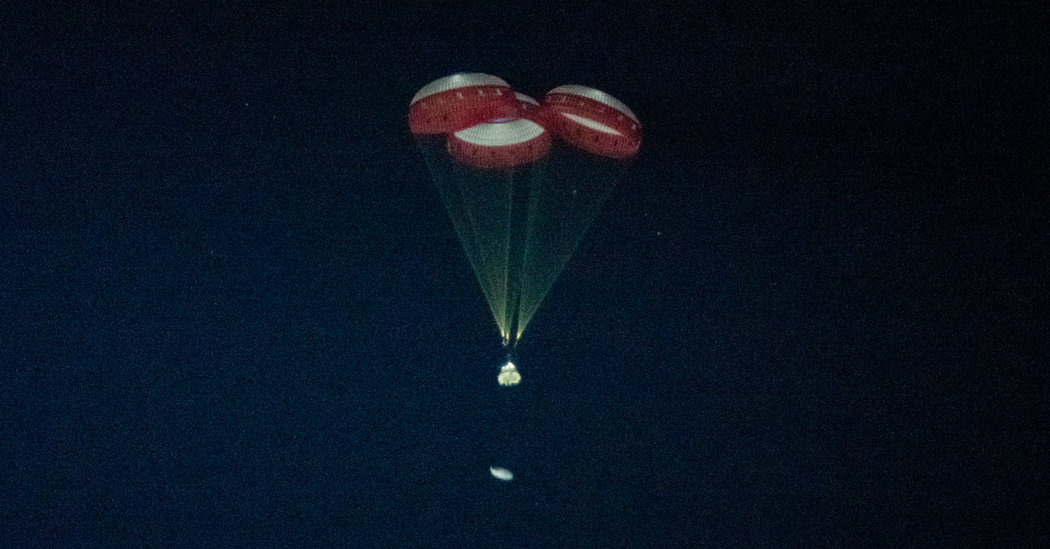Boeing’s new spacecraft, the CST-100 Starliner, properly parachuted to Earth on Sunday, landing atop inflated airbags before dawn at the White Sands Missile Array in New Mexico.
“It was an absolute bull’s-eye,” stated Jim Bridenstine, the NASA administrator through a information meeting soon after the landing.
The harmless and seemingly flawless return of the capsule, which did not have any people aboard, supplied an upbeat ending to a mission that began unhappily when a clock challenge caused the spacecraft to deplete its propellant. A prepared docking at the Worldwide Place Station was named off, and the capsule returned immediately after only two times in orbit.
“Make no miscalculation,” Mr. Bridenstine claimed. “This did not go according to prepare in every single way we would have hoped. But it is also true that we obtained a great deal of definitely very good information so that we can maintain earning meaningful progress.”
The mishap on Friday included to a week of terrible information for Boeing, which declared its business airplane division would temporarily halt generation of the 737 Max, its most well known passenger jet, which crashed in 2018 and 2019 and was subsequently grounded.
How the shortened flight impacts the Starliner plan and NASA’s plans to resume launching of astronauts on American rockets from American soil is not nonetheless known.
Diagnosing and fixing the clock problem could insert delays to the business crew program, NASA’s method of relying on non-public businesses to develop spacecraft to have astronauts to and from the area station. It is currently much more than two a long time behind its primary timeline.
Jim Chilton, senior vice president of the area and start division at Boeing, approximated that the mission attained adequate details to satisfy 85 to 90 p.c of the test aims.
“The vessel seems to be wonderful,” Mr. Chilton explained. “They’re telling us there is barely any charring, beautifully level on her airbags. And that bodes actually properly for reusability.”
The Starliner capsule will be transported again to Kennedy Place Middle in Florida, exactly where it will be refurbished. Each capsule is intended to fly up to 10 instances, and this one particular is at present scheduled to head to room once again, this time with astronauts, in the second half of 2020.
Before then, Boeing is to fly yet another exam flight, but with astronauts aboard.
Steve Stich, deputy supervisor of the industrial crew system for NASA, said teams from the agency and Boeing will invest months analyzing the data.
“To me, there’s excellent details out there that suggests that after we go via it, perhaps it’s suitable to go, future move, fly the crewed flight examination,” Mr. Stich claimed. “But we have to go by means of the details to start with.”
Mr. Chilton agreed that it was way too early to say regardless of whether the subsequent Starliner flight will have astronauts aboard. “We’re not in posture to suggest that and we really don’t propose it till we know the equipment is worthy,” he mentioned.
About 50 percent an hour prior to landing, thrusters fired for 55 seconds to fall the spacecraft out of orbit. That established off an automatic choreography — jettisoning pieces no extended wanted, deploying parachutes, inflating the airbags — that appeared to unfold flawlessly. The capsule touched down in the freezing desert ahead of sunrise in the vicinity of a former space shuttle runway.
“It was just photo fantastic,” Sunita Williams, the NASA astronaut who is to be the commander of the following flight of this capsule. She was at White Sands as part of the staff inspecting the capsule after landing.
At the invitation of Boeing, Ms. Williams explained she would like to identify the spacecraft Calypso right after the ship utilized by Jacques Cousteau to discover the oceans.
The return of the capsule on land was abnormal, at least for NASA. All prior landings of its capsules — the Mercury, Gemini and Apollo applications of the 1960s and 1970s — had been in the ocean. Soon after all, you may be safer diving into water than an expanse of sand.
But Russian astronauts have often landed on good ground, and that technique features rewards. Salt h2o corrodes steel, which would complicate ideas to reuse Starliner capsules for future missions. Also, a capsule hitting an ocean wave at the completely wrong angle could sink. (That is what transpired throughout tests of Apollo capsules, requiring a revamping of the style and design.)
Even though NASA and Boeing had numerous explanations to celebrate on Sunday, the mission went awry in a puzzling way on Friday. Quite simply, Starliner acquired the time improper.
When the spacecraft divided from the Atlas 5 rocket that lifted it to place, an incorrect clock, off by 11 several hours, prompted it to start out firing its thrusters and check out to get into the placement and orientation exactly where it thought it really should be.
“She considered she was later in the mission,” Mr. Chilton mentioned on Saturday, “and staying autonomous, commenced to behave that way.”
Boeing does not know what went improper.
“If I understood, it would not have happened” Mr. Chilton explained. “We were stunned.”
The spacecraft’s computer software set its clock primarily based on the time it acquired from the Atlas 5 rocket before launch, and it is still also early to notify how it pulled the incorrect information, reported Mr. Chilton. He added that the issue was with the Boeing software package, not with the rocket, which was crafted and operated by a further business, the United Launch Alliance.
This flight did not have any person on board, but NASA and Boeing officers insist that if astronauts experienced been in the capsule, they would have been secure. The astronauts might even have been able to take above handbook handle and send out the spacecraft on the proper path.
Flight controllers ended up finally in a position to mail Starliner the suitable time. They then carried out a pair of thruster firings to increase its orbit to a circular a person 155 miles earlier mentioned the surface area. That was decreased than the Intercontinental Area Station, which is at an altitude of about 250 miles.
In the course of its abbreviated time in orbit, the spacecraft’s propulsion, navigation and life assist methods appeared to function nicely. Even even though the Starliner did not go to the area station, flight controllers were being capable to take a look at some of the techniques essential to the rendezvous. That integrated establishing a conversation link concerning the spacecraft and station and extending, then retracting a ring that would have hooked up to the docking port.
The two portions of the mission of finest threat to astronauts — launch and return to Earth — have been demonstrated.
NASA however hopes to have astronauts to orbit once more in the very first half of 2020, and has also employed another firm, SpaceX, to get crews to the place station.
The trouble with Boeing’s Starliner does not right have an impact on SpaceX’s capsule, Crew Dragon, which concluded its very first trip to and from the place station in March. But SpaceX has encountered its individual hurdles and delays, and continue to has to finish tests of its parachute and perform an in-flight take a look at of its abort procedure, prior to it is ready to have astronauts. That launch is at present scheduled for Jan. 11.
NASA has already talked to Russia about obtaining further seats on the Soyuz rockets, which have been the only transportation offered to astronauts to and from the International Space Station since 2011.







Leave a Reply